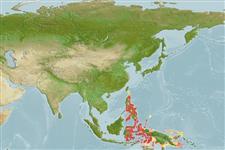Common names from other countries
Environment: milieu / climate zone / depth range / distribution range
Ecologie
marien rifbewoner; diepte 0 - 30 m (Ref. 9710). Tropical; 23°N - 11°S, 120°E - 154°E (Ref. 5222)
Western Pacific: Vietnam, Indonesia, Philippines, Taiwan, Solomon Islands (Ref. 4787) and New Britain.
Grootte / Gewicht / Leeftijd
Maturity: Lm ? range ? - ? cm
Max length : 30.0 cm TL mannelijk / geslacht onbekend; (Ref. 5222)
Dorsale stekels (totaal) : 11; Dorsale zachte stralen (totaal) : 16 - 17; Anale stekels: 3; Anale zachte stralen: 8. Characterized by grey brown color with scattered reddish brown to black spots; narrow pale margins on dark grey fins; body scales ctenoid, except cycloid scales dorsally and ventrally; body with auxiliary scales; greatest depth of body 2.8-3.2 in SL; rounded caudal fin; pelvic fins, 1.9-2.3 in head length (Ref. 90102); head length 2.3-2.6 times in SL; interorbital area flat to slightly convex, almost straight dorsal head profile; rounded preopercle, finely serrate, ventral serrae slightly enlarged; straight upper edge of operculum; maxilla reaches past rear edge of eye; 2 or 3 rows of teeth on midlateral part of lower jaw (Ref. 089707).
Found on mud or rocky or cobble bottoms (Ref. 089707). The species appears to be one of the rarest groupers in the Indo-Pacific region, nothing has been published on its biology. Solitary (Ref 90102).
Levenscyclus en paargedrag
Maturities | Voortplanting | Spawnings | Egg(s) | Fecundities | Larven
Heemstra, P.C. and J.E. Randall, 1993. FAO Species Catalogue. Vol. 16. Groupers of the world (family Serranidae, subfamily Epinephelinae). An annotated and illustrated catalogue of the grouper, rockcod, hind, coral grouper and lyretail species known to date. Rome: FAO. FAO Fish. Synop. 125(16):382 p. (Ref. 5222)
Status op de Rode Lijst van het IUCN (Ref. 130435)
CITES (Ref. 128078)
Not Evaluated
Gevaar voor de mens
Harmless
Gebruik door de mens
Visserij: van geen belang
Tools
Speciale rapporten
Download XML
Internetbronnen
Estimates based on models
Preferred temperature (Ref.
115969): 27.9 - 29.2, mean 28.8 (based on 557 cells).
Fylogenetische diversiteitsindex (Ref.
82804): PD
50 = 0.5000 [Uniqueness, from 0.5 = low to 2.0 = high].
Bayesian length-weight: a=0.01175 (0.00571 - 0.02419), b=3.04 (2.88 - 3.20), in cm Total Length, based on LWR estimates for this Genus-body shape (Ref.
93245).
Trofisch niveau (Ref.
69278): 3.7 ±0.6 se; based on size and trophs of closest relatives
Weerstandsvermogen (Ref.
120179): Gemiddeld, minimale populatieverdubbelingstijd 1,4-4,4 jaar (Preliminary K or Fecundity.).
Fishing Vulnerability (Ref.
59153): Low vulnerability (20 of 100).
